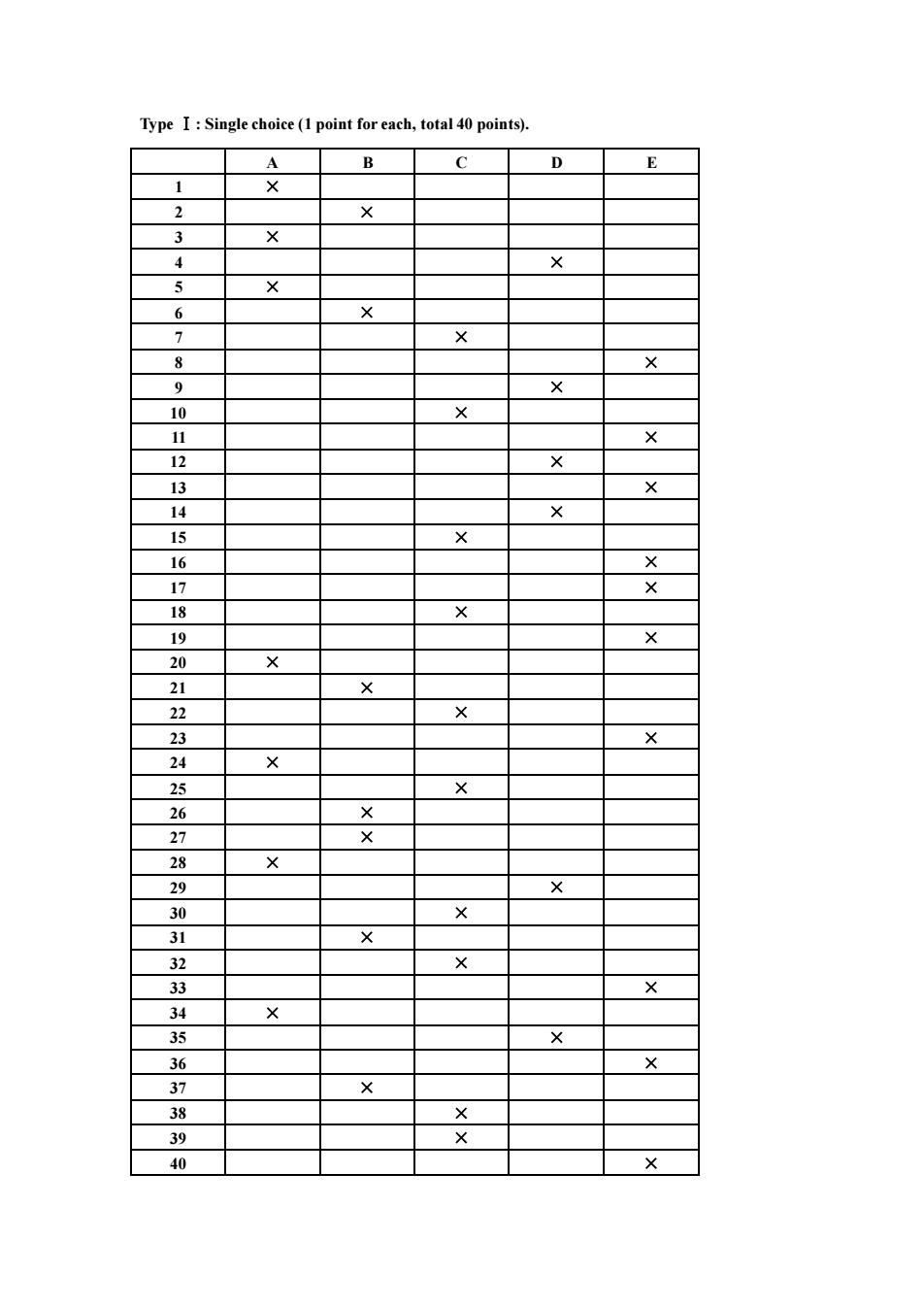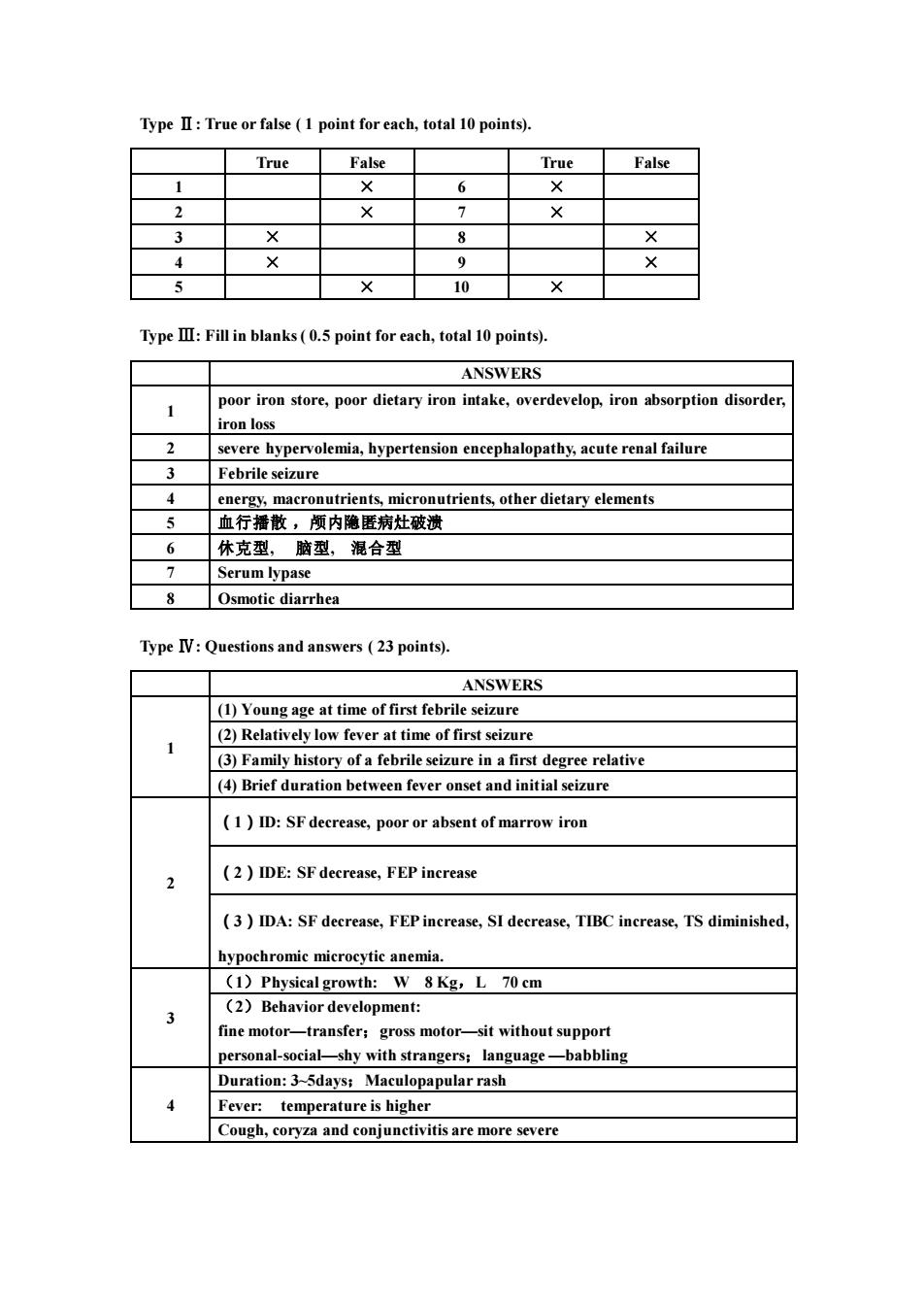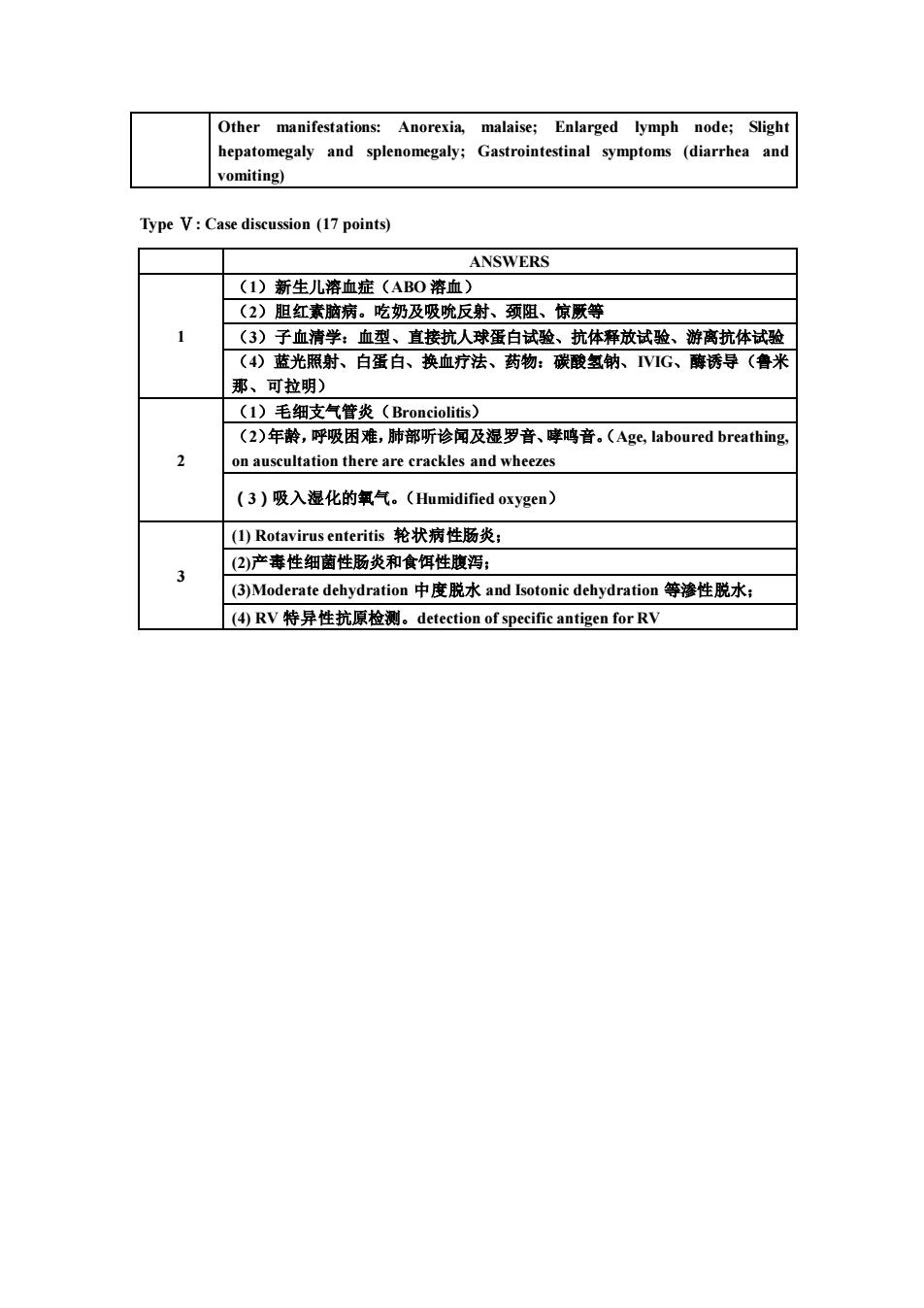
Iype I :Singlechoice (1 pointforeach, total 40 points)A1X2x34+5+789X10X11X1314+15X16X1718X192021X2223X24X25X26X27X2829X3031X323X34353637+38X39+40
Type Ⅰ: Single choice (1 point for each, total 40 points). A B C D E 1 × 2 × 3 × 4 × 5 × 6 × 7 × 8 × 9 × 10 × 11 × 12 × 13 × 14 × 15 × 16 × 17 × 18 × 19 × 20 × 21 × 22 × 23 × 24 × 25 × 26 × 27 × 28 × 29 × 30 × 31 × 32 × 33 × 34 × 35 × 36 × 37 × 38 × 39 × 40 ×

Type I : True or false (1 point for each, total 10 points)TrueFalsTruFalseXXType II: Fillin blanks (0.5 point for each, total 10 points).ANSWERSpoor iron store, poor dietary iron intake, overdevelop, iron absorption disorder,ironlosssevere hypervolemia, hypertension encephalopathy, acute renal failureFebrile seizureenergy, macronutrients, micronutrients,other dietary elements血行播散,颅内隐匿病灶破溃休克型,脑型,混合型SerumlypaseOsmotic diarrheaType IV: Questions and answers (23 points).ANSWERS() Young age at time of first febrile seizure(2) Relatively low fever at time of first seizure3) Family history of a febrile seizure in a first degree relative(4) Brief duration betweenfever onset and initial seizure(1) D: SF decrease, poor or absent of marrow iron(2) IDE: SF decrease, FEP increase(3)DA: SF decreasee,FEPincrease, SI decrease,TIBC increase,TS diminished,hypochromic microcytic anemia.(1) Physical growth: W 8Kg, L 70 cm(2)Behavior development:finemotor-transfer; gross motorsit without supportpersonal-social-shy with strangers; language-babblingDuration:3-5days;Maculopapular rashtemperature is higherFever:Cough, coryza and conjunctivitis are more severe
Type Ⅱ: True or false ( 1 point for each, total 10 points). True False True False 1 × 6 × 2 × 7 × 3 × 8 × 4 × 9 × 5 × 10 × Type Ⅲ: Fill in blanks ( 0.5 point for each, total 10 points). ANSWERS 1 poor iron store, poor dietary iron intake, overdevelop, iron absorption disorder, iron loss 2 severe hypervolemia, hypertension encephalopathy, acute renal failure 3 Febrile seizure 4 energy, macronutrients, micronutrients, other dietary elements 5 血行播散 ,颅内隐匿病灶破溃 6 休克型, 脑型, 混合型 7 Serum lypase 8 Osmotic diarrhea Type Ⅳ: Questions and answers ( 23 points). ANSWERS 1 (1) Young age at time of first febrile seizure (2) Relatively low fever at time of first seizure (3) Family history of a febrile seizure in a first degree relative (4) Brief duration between fever onset and initial seizure 2 (1)ID: SF decrease, poor or absent of marrow iron (2)IDE: SF decrease, FEP increase (3)IDA: SF decrease, FEP increase, SI decrease, TIBC increase, TS diminished, hypochromic microcytic anemia. 3 (1)Physical growth: W 8 Kg,L 70 cm (2)Behavior development: fine motor—transfer;gross motor—sit without support personal-social—shy with strangers;language —babbling 4 Duration: 3~5days;Maculopapular rash Fever: temperature is higher Cough, coryza and conjunctivitis are more severe

Othernanifestations:Anorexia, malaise; Enlarged lymph node; Slighthepatomegaly and splenomegaly; Gastrointestinal symptoms (diarrhea andvomiting)Type V: Case discussion (17 points)ANSWERS(1)新生儿溶血症(ABO溶血)(2)胆红素脑病。吃奶及吸反射、颈阻、惊厥等(3)子血清学:血型、直接抗人球蛋白试验、抗体释放试验、游离抗体试验(4)蓝光照射、白蛋白、换血疗法、药物:碳酸氢钠、IVIG、酶诱导(鲁米那、可拉明)(1)毛细支气管炎(Bronciolitis)(2)年龄,呼吸困难,肺部听诊闻及湿罗音、哮鸣音。(Age,laboured breathing,scultation there are crackles and wheeze(3)吸入湿化的氧气。(Humidified oxygen)(1)Rotavirusenteritis轮状病性肠炎:(2)产毒性细菌性肠炎和食饵性腹泻;(3)Moderate dehydration中度脱水and Isotonic dehydration等渗性脱水;(4)RV特异性抗原检测。detectionofspecific antigenforRV
Other manifestations: Anorexia, malaise; Enlarged lymph node; Slight hepatomegaly and splenomegaly; Gastrointestinal symptoms (diarrhea and vomiting) Type Ⅴ: Case discussion (17 points) ANSWERS 1 (1)新生儿溶血症(ABO 溶血) (2)胆红素脑病。吃奶及吸吮反射、颈阻、惊厥等 (3)子血清学:血型、直接抗人球蛋白试验、抗体释放试验、游离抗体试验 (4)蓝光照射、白蛋白、换血疗法、药物:碳酸氢钠、IVIG、酶诱导(鲁米 那、可拉明) 2 (1)毛细支气管炎(Bronciolitis) (2)年龄,呼吸困难,肺部听诊闻及湿罗音、哮鸣音。(Age, laboured breathing, on auscultation there are crackles and wheezes (3)吸入湿化的氧气。(Humidified oxygen) 3 (1) Rotavirus enteritis 轮状病性肠炎; (2)产毒性细菌性肠炎和食饵性腹泻; (3)Moderate dehydration 中度脱水 and Isotonic dehydration 等渗性脱水; (4) RV 特异性抗原检测。detection of specific antigen for RV